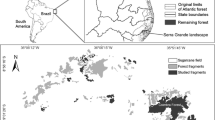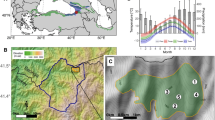Abstract
We focused our attention on quantifying the factor complex of forest regeneration in 423 mature and old stands with contrasting environmental conditions. We recorded the microhabitat selection of tree recruits, the frequency of tree seedlings, and evaluated the drivers of sapling abundance and diversity. The majority of forest regeneration was established on undisturbed forest floor. Dead wood was a frequent substrate in spruce-(co)dominated forests. Seedling frequency within a stand was related to the site-type specific productivity gradient of stands—pine seedlings were common in low-productivity and spruce in high-productivity boreal forests. Seedlings of temperate broad-leaved trees dominated in productive boreonemoral forests, except for oak, which showed a uniform distribution of abundance in all forest site-types. Sapling abundance was dictated by forest site-type, and facilitated by stand diversity, variability in stand closure, lying dead wood, abundant moss, and a thick organic layer. Only in boreal forests was sapling abundance suppressed by the abundant spruce and younger trees. Upon considering the relationship between sapling abundance and species richness, sapling diversity was dependent on forest site-type, suppressed by stand density and dead wood (old gap) abundance, and facilitated by stand diversity. In addition, boreonemoral stands, competition from herbs, and facilitation by mosses occurred. The observed pattern of tree recruitment points to the importance of top-down effects of the overstory, competing or facilitating interactions with forest floor vegetation, and availability of regeneration microhabitats, which in complex make their ecology comparable with forest herbs. Natural forest regeneration can be enhanced if silvicultural methods support mixed stands and enhance field layer diversity. Oak can provide the universal tree species to improve stand structure over a wide range of habitats.



Similar content being viewed by others
References
Adermann V (2009) Estonian forests 2008. The estimation of forest sources by statistical sampling methodology (in Estonian with English summary). Metsakaitse- ja Metsauuenduskeskus, Tallinn
Ahti T, Hämet-Ahti L, Jalas J (1968) Vegetation zones and their sections in northwestern Europe. Ann Bot Fenn 5:169–211
Andersson L, Martverk R, Külvik M, Palo A, Varblane A (2003) Woodland key habitat inventory in Estonia 1999–2002. Regio, Tartu
Angelstam P, Majewski P, Bondrup-Nielsen S (1995) West-East cooperation in Europe for sustainable boreal forests. Water Air Soil Pollut 82:3–11
Aunap R, Ainsaar L, Rattas M, Mardiste H, Jaagus J, Kull A, Ahas R, Aasa A, Järvet A, Rooma I, Tarre A, Kuusk V, Arold I, Remm K, Tikk U, Tammarum T, Kask I, Pae T, Liiber Ü, Rõivas T, Thomson H, Vessin U, Kurs O (2004) Eesti atlas (Atlas of Estonia). Avita, Tartu
Axelsson AL, Östlund L (2001) Retrospective gap analysis in a Swedish boreal forest landscape using historical data. For Ecol Manag 147:109–122
Beckage B, Clark JS (2003) Seedling survival and growth of three forest tree species: the role of spatial heterogeneity. Ecology 84:1849–1861
Bengtsson J, Nilsson SG, Franc A, Menozzi P (2000) Biodiversity, disturbances, ecosystem function and management of European forests. For Ecol Manag 132:39–50
Chrimes D, Nilson K (2005) Overstorey density influence on the height of Picea abies regeneration in northern Sweden. Forestry 78:433–442
D’Orangeville L, Bouchard A, Cogliastro A (2008) Post-agricultural forests: landscape patterns add to stand-scale factors in causing insufficient hardwood regeneration. For Ecol Manag 255:1637–1646
Dehlin H, Nilsson MC, Wardle DA, Shevtsova A (2004) Effects of shading and humus fertility on growth, competition, and ectomycorrhizal colonization of boreal forest tree seedlings. Can J For Res 34:2573–2586
Dzwonko Z, Gawronski S (1994) The role of woodland fragments, soil types, and dominant species in secondary succession on the western Carpathian foothills. Vegetatio 111:149–160
Ekbom B, Schroeder LM, Larsson S (2006) Stand specific occurrence of coarse woody debris in a managed boreal forest landscape in central Sweden. For Ecol Manag 221:2–12
Flinn KM, Vellend M (2005) Recovery of forest plant communities in post-agricultural landscapes. Front Ecol Environ 3:243–250
Greene DF, Zasada JC, Sirois L, Kneeshaw D, Simard MJ, Morin H, Charron I (1999) A review of the regeneration dynamics of North American boreal forest tree species. Can J For Res 29:824–839
Grigg D (1987) The industrial revolution and land transformation. In: Wolman MG, Fournier FGA (eds) Land transformation in agriculture. Wiley, Chichester, pp 79–109
Grubb PJ (1977) The maintenance of species-richness in plant communities: the importance of the generation niche. Biol Rev 52:107–145
Hanssen KH (2003) Natural regeneration of Picea abies on small clear-cuts in SE Norway. For Ecol Manag 180:199–213
Jäderlund A, Zackrisson O, Dahlberg A, Nilsson MC (1997) Interference of Vaccinium myrtillus on establishment, growth, and nutrition of Picea abies seedlings in a northern boreal site. Can J For Res 27:2017–2025
Jantunen J, Saarinen K, Saarnio S, Marttila O (2002) Stand structure in pine, spruce and deciduous forests: a comparison between Finnish and Russian Karelia. Scand J For Res 17:53–61
Kohv K, Liira J (2005) Anthropogenic effects on vegetation structure of the boreal forest in Estonia. Scand J For Res 20:122–134
Kuuluvainen T (1994) Gap disturbance, ground microtopography, and the regeneration dynamics of boreal coniferous forests in Finland: a review. Ann Zool Fenn 31:35–51
Kuuluvainen T, Aapala K, Ahlroth P, Kuusinen M, Lindholm T, Sallantaus T, Siitonen J, Tukia H (2002) Principles of ecological restoration of boreal forested ecosystems: Finland as an example. Silva Fenn 36:409–422
Kwit C, Platt WJ (2003) Disturbance history influences regeneration of non-pioneer understory trees. Ecology 84:2575–2581
Lähde E, Laiho O, Norokorpi Y (1999) Diversity-oriented silviculture in the Boreal Zone of Europe. For Ecol Manag 118:223–243
Leemans R (1991) Canopy gaps and establishment patterns of spruce (Picea abies (L.) Karst.) in two old-growth coniferous forests in central Sweden. Vegetatio 93:157–165
Lieffers VJ, Stadt KJ, Messier C, Gendron F, Comeau PG (1999) Predicting and managing light in the understory of boreal forests. Can J For Res 29:796–811
Liira J, Kohv K (2010) Stand characteristics and biodiversity indicators along the productivity gradient in boreal forests: defining a critical set of indicators for the monitoring of habitat nature quality. Plant Biosyst 144:211–220
Liira J, Sepp T (2009) Indicators of structural and habitat natural quality in boreo-nemoral forests along the management gradient. Ann Bot Fenn 46:308–325
Liira J, Zobel K, Magi R, Molenberghs G (2002) Vertical structure of herbaceous canopies: the importance of plant growth-form and species-specific traits. Plant Ecol 163:123–134
Liira J, Sepp T, Parrest O (2007) The forest structure and ecosystem quality in conditions of anthropogenic disturbance along productivity gradient. For Ecol Manag 250:34–46
Linder P, Östlund L (1998) Structural changes in three mid-boreal Swedish forest landscapes, 1885–1996. Biol Conserv 85:9–19
Lõhmus E (2004) Eesti metsakasvukohatüübid. Eesti Loodusfoto, Tartu
Lõhmus A, Kraut A (2010) Stand structure of hemiboreal old-growth forests: characteristic features, variation among site types, and a comparison with FSC-certified mature stands in Estonia. For Ecol Manag 260:155–165
Loreau M, Naeem S, Inchausti P, Bengtsson J, Grime JP, Hector A, Hooper DU, Huston MA, Raffaelli D, Schmid B, Tilman D, Wardle DA (2001) Ecology: biodiversity and ecosystem functioning: current knowledge and future challenges. Science 294:804–808
Messier C, Claveau Y, Kelly C, Doucet R, Ruel JC, Lechowicz MJ (1999) Functional ecology of advance regeneration in relation to light in boreal forests. Can J For Res 29:812–823
Mori A, Takeda H (2003) Light-related competitive effects of overstory trees on the understory conifer saplings in a subalpine forest. J For Res 8:163–168
Paal J (1997) Eesti taimkatte kasvukohatüüpide klassifikatsioon (Classification of Estonian vegetation site types). Keskkonnaministeeriumi Info- ja Tehnokeskus, Tallinn
Paal J (2007) The handbook of Natura 2000 habitat types according to Habitat directive (in Estonian with English summary). Eesti Keskkonnaministeerium, Tallinn
Page LM, Cameron AD (2006) Regeneration dynamics of Sitka spruce in artificially created forest gaps. For Ecol Manag 221:260–266
Püssa K, Liira J, Peterson U (2005) The effects of successional age and forest site type on radiance of forest clear-cut communities. Scand J For Res 20:79–87
Rosenvald R, Lõhmus A (2008) For what, when, and where is green-tree retention better than clear-cutting? A review of the biodiversity aspects. For Ecol Manag 255:1–15
Ryan KC (2002) Dynamic interactions between forest structure and fire behavior in boreal ecosystems. Silva Fenn 36:13–39
Smidt MF, Puettmann KJ (1998) Overstory and understory competition affect underplanted eastern white pine. For Ecol Manag 105:137–150
Svoboda M, Fraver S, Janda P, Bace R, Zenáhlíková J (2010) Natural development and regeneration of a Central European montane spruce forest. For Ecol Manag 260:707–714
Tahvonen O, Pukkala T, Laiho O, Lähde E, Niinimäki S (2010) Optimal management of uneven-aged Norway spruce stands. For Ecol Manag 260:106–115
Uotila A, Kouki J (2005) Understorey vegetation in spruce-dominated forests in eastern Finland and Russian Karelia: successional patterns after anthropogenic and natural disturbances. For Ecol Manag 215:113–137
Van Calster H, Vandenberghe R, Ruysen M, Verheyen K, Hermy M, Decocq G (2008) Unexpectedly high 20th century floristic losses in a rural landscape in northern France. J Ecol 96:927–936
Van Couwenberghe R, Collet C, Lacombe E, Pierrat JC, Gegout JC (2010) Gap partitioning among temperate tree species across a regional soil gradient in windstorm-disturbed forests. For Ecol Manag 260:146–154
Wolf A (2005) Fifty year record of change in tree spatial patterns within a mixed deciduous forest. For Ecol Manag 215:212–223
Zar JH (2010) Biostatistical analysis. Prentice Hall, Englewood Cliffs
Zobel K, Liira J (2000) The species richness–biomass relationship in herbaceous plant communities: what difference does the incorporation of root biomass data make? Oikos 91:109–114
Acknowledgments
The research was supported by Estonian Science Foundation grants nos. 5478 and 7878, the Estonian Ministry of Education and Research (target-financing projects at the University of Tartu, SF0180098s08, SF0180012s09) and the European Union through the European Regional Development Fund (Centre of Excellence FIBIR). We are grateful to Asko Lõhmus and Alexander Harding for their comments on the manuscript, and Oliver Parrest for his assistance in field.
Author information
Authors and Affiliations
Corresponding author
About this article
Cite this article
Liira, J., Sepp, T. & Kohv, K. The ecology of tree regeneration in mature and old forests: combined knowledge for sustainable forest management. J For Res 16, 184–193 (2011). https://doi.org/10.1007/s10310-011-0257-6
Received:
Accepted:
Published:
Issue Date:
DOI: https://doi.org/10.1007/s10310-011-0257-6




